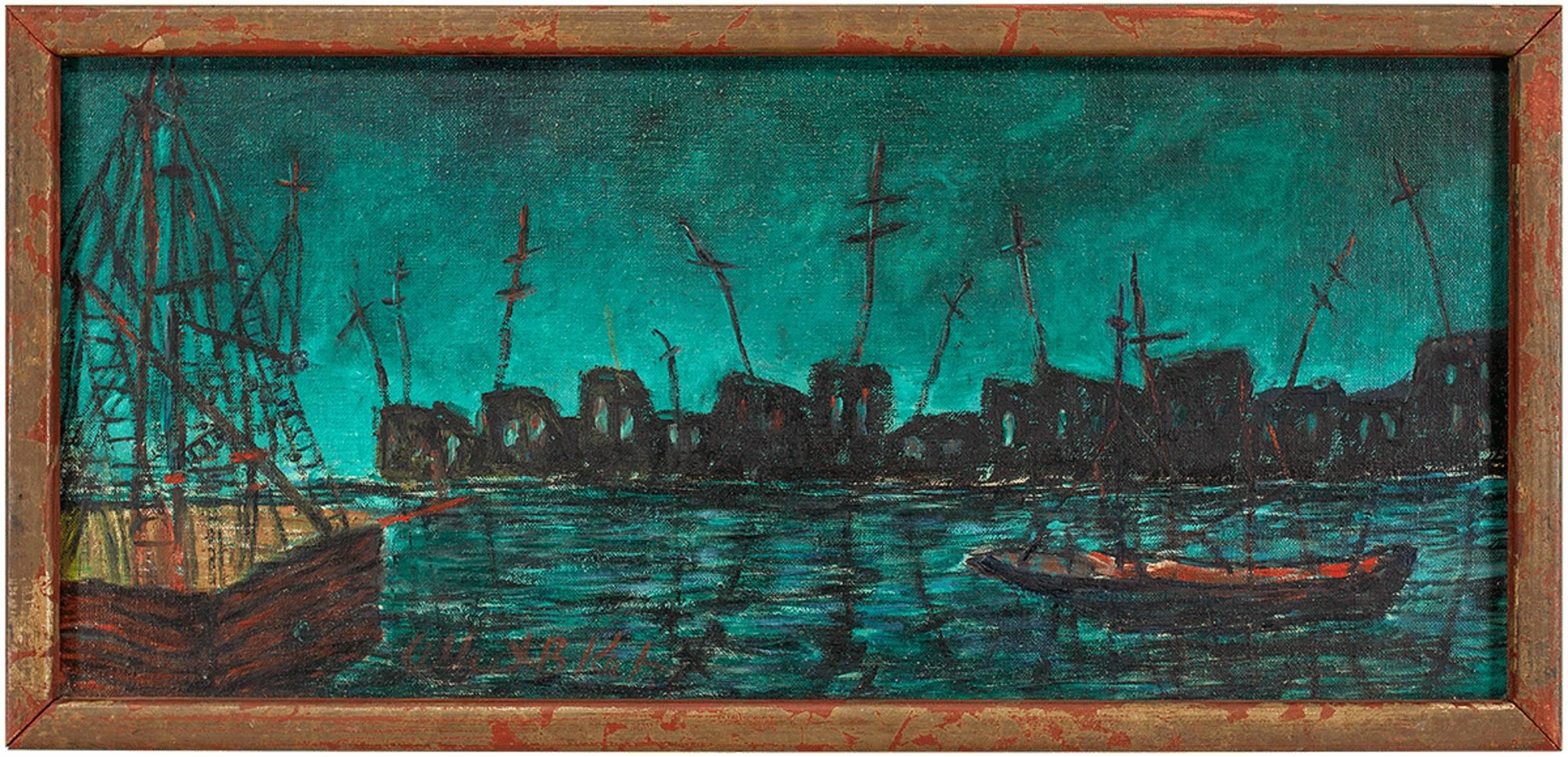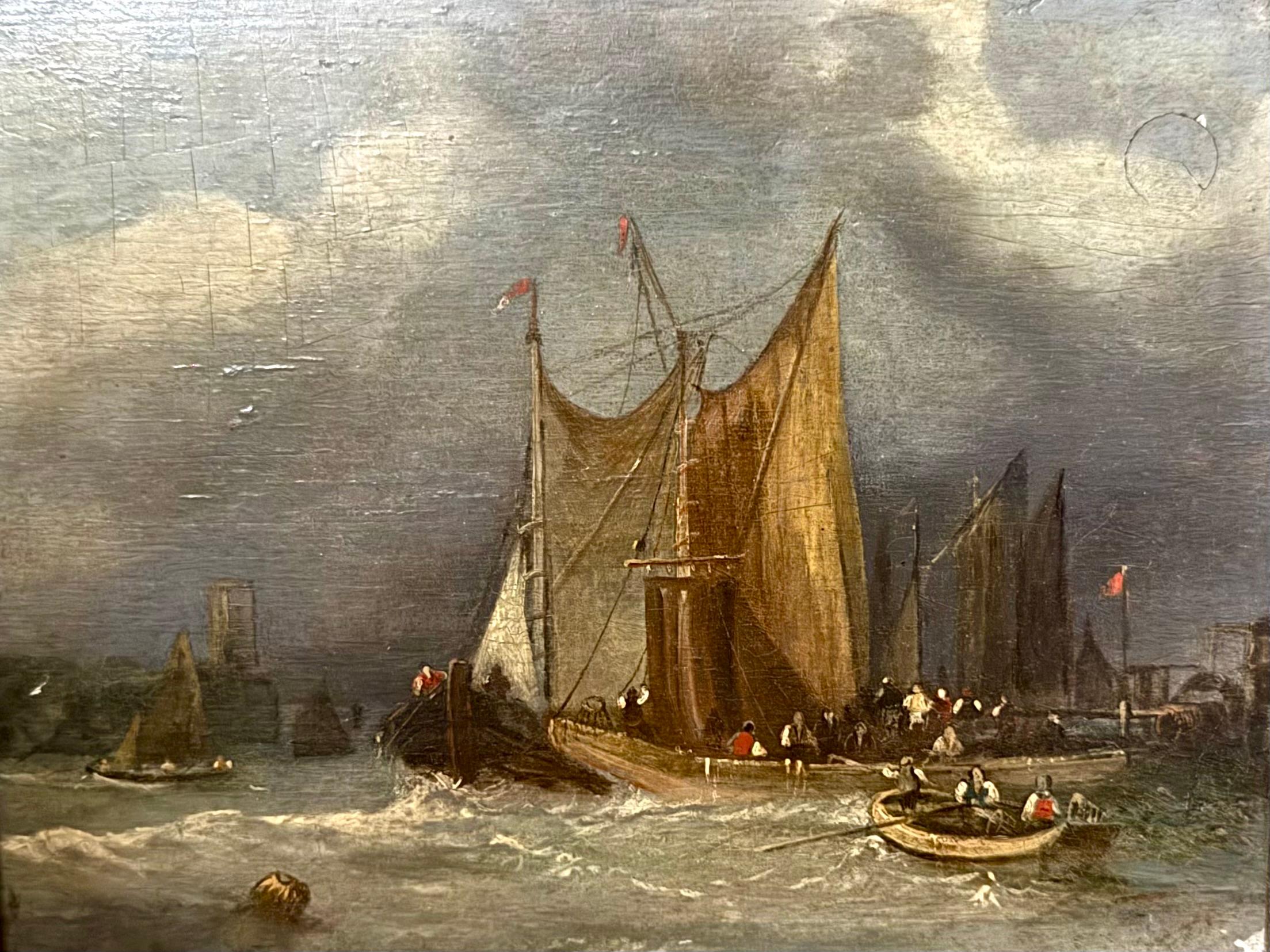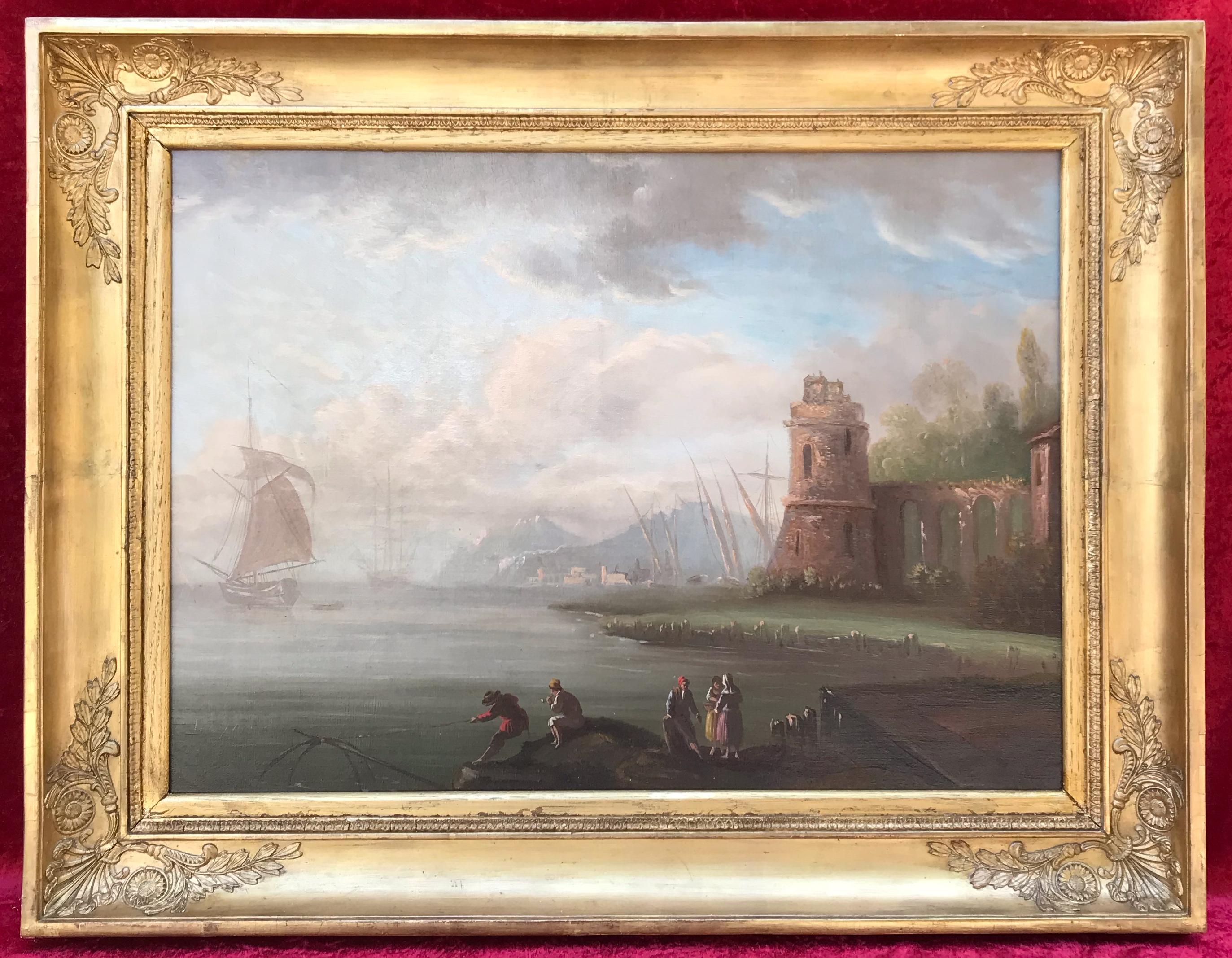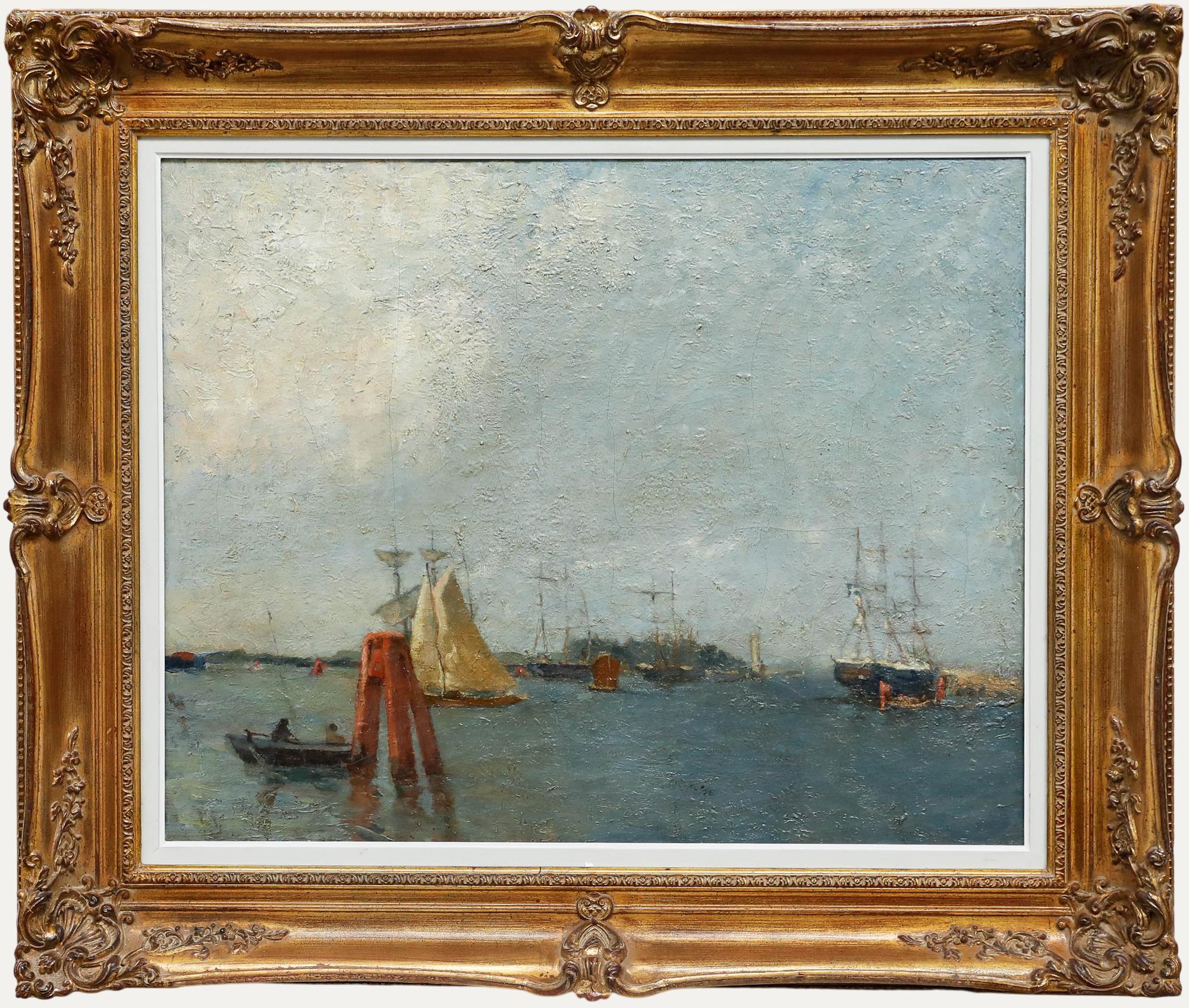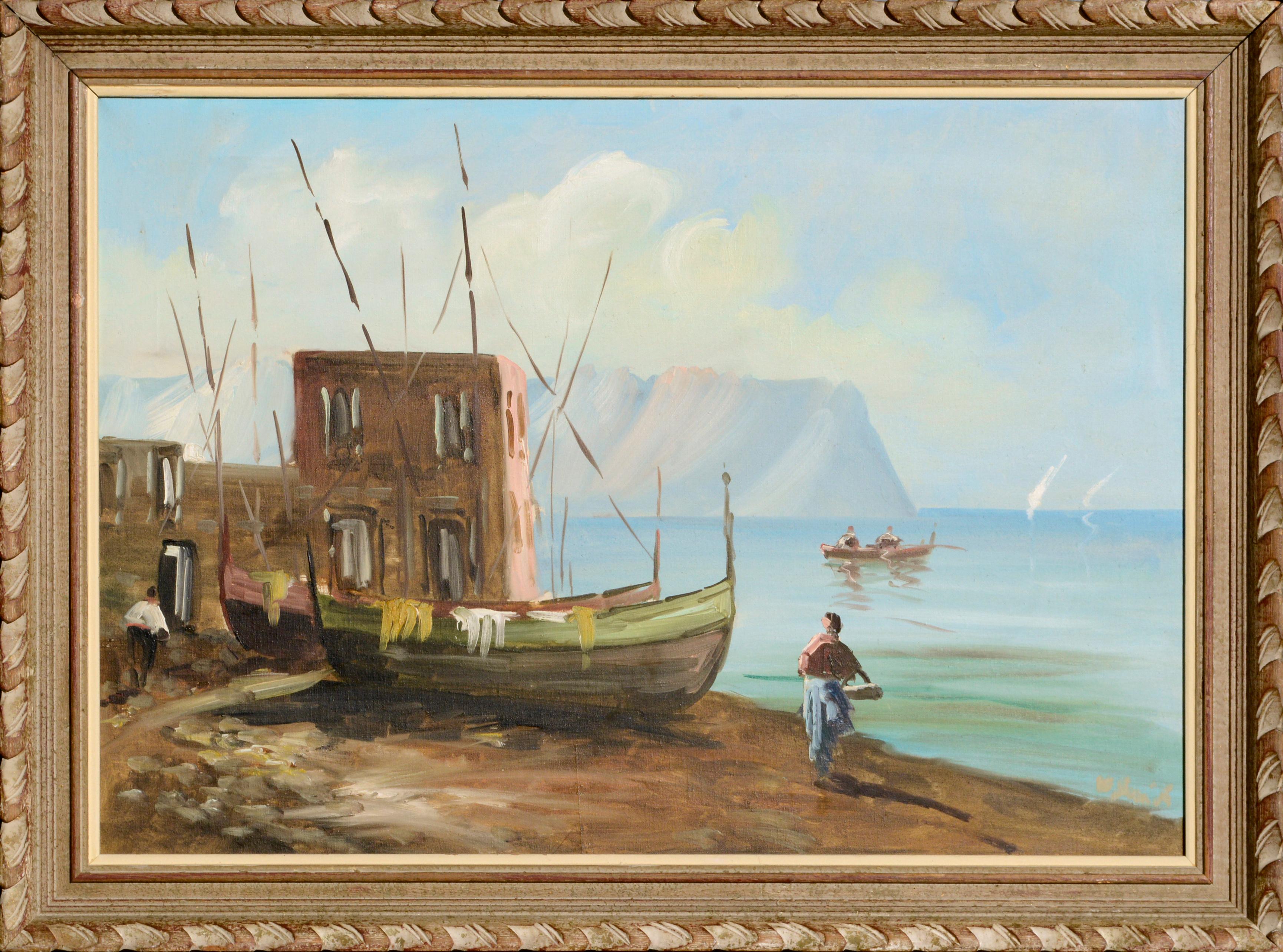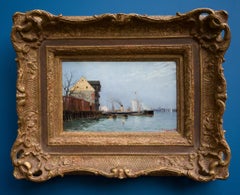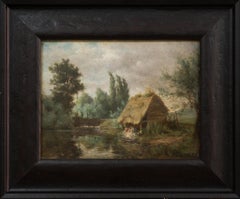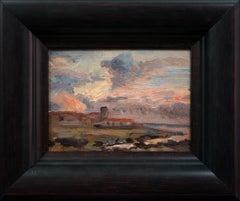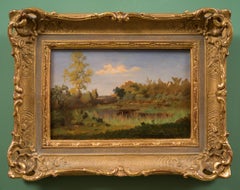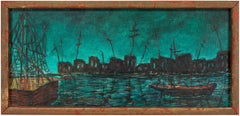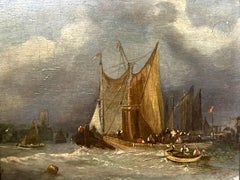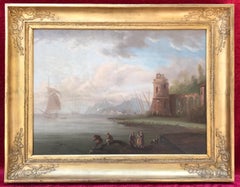Items Similar to Maritime Scene with Sailboats
Want more images or videos?
Request additional images or videos from the seller
1 of 10
UnknownMaritime Scene with SailboatsLate 1800s
Late 1800s
$1,850
£1,408
€1,612.20
CA$2,631.33
A$2,882.68
CHF 1,505.85
MX$34,655.60
NOK 18,825.80
SEK 17,755.73
DKK 12,035.85
About the Item
This captivating maritime painting, likely the work of an English artist, dates to the late 19th century and showcases a masterful command of light and texture. The composition features several boats gently navigating calm waters, one of which carries a French flag.
The true charm of this piece lies in the artist’s light and delicate brushwork, executed with exceptional skill and subtlety. The interplay of soft, muted tones and dynamic details captures the serene atmosphere of the moment, drawing the viewer into the quiet beauty of life at sea.
Signed "Hudson," the identity of the artist remains a mystery, yet their talent is evident in the graceful rendering of the scene.
Provenance:
A Swedish private collection.
- Creation Year:Late 1800s
- Dimensions:Height: 14.57 in (37 cm)Width: 18.51 in (47 cm)
- Medium:
- Movement & Style:
- Period:
- Condition:Overall good condition. lower right corner is missing. paper board glued on a wood panel. New gold gilded frame is included.
- Gallery Location:Stockholm, SE
- Reference Number:1stDibs: LU1445215683882
About the Seller
5.0
Platinum Seller
Premium sellers with a 4.7+ rating and 24-hour response times
Established in 2020
1stDibs seller since 2020
200 sales on 1stDibs
Typical response time: <1 hour
Associations
International Confederation of Art and Antique Dealers' Associations
- ShippingRetrieving quote...Shipping from: Stockholm, Sweden
- Return Policy
Authenticity Guarantee
In the unlikely event there’s an issue with an item’s authenticity, contact us within 1 year for a full refund. DetailsMoney-Back Guarantee
If your item is not as described, is damaged in transit, or does not arrive, contact us within 7 days for a full refund. Details24-Hour Cancellation
You have a 24-hour grace period in which to reconsider your purchase, with no questions asked.Vetted Professional Sellers
Our world-class sellers must adhere to strict standards for service and quality, maintaining the integrity of our listings.Price-Match Guarantee
If you find that a seller listed the same item for a lower price elsewhere, we’ll match it.Trusted Global Delivery
Our best-in-class carrier network provides specialized shipping options worldwide, including custom delivery.More From This Seller
View AllA Harbor Scene from 1884
Located in Stockholm, SE
Carl Flodman (1863-1888) Swede
A Harbor Scene from 1884
oil on wood panel
signed and dated C.Flodman 84
unframed: 13 x 21 cm (5 1/8 x 8 1/4 in)
framed: 29 x 37.5 cm (11 3/8 x 14 3/...
Category
1880s Romantic Landscape Paintings
Materials
Oil, Wood Panel
$4,387 Sale Price
25% Off
Rustic Charm of the French Countryside, French School
Located in Stockholm, SE
We are pleased to offer this exquisite mid-19th century French painting, a serene landscape that beautifully captures the tranquility of rural life. This piece is signed "Ph ..." (th...
Category
Mid-19th Century French School Landscape Paintings
Materials
Oil, Wood Panel
Coastal Landscape with Dramatic Clouds
Located in Stockholm, SE
We are pleased to offer a captivating small oil painting by the Swedish artist Georg Stoopendaal. Despite its modest dimensions of 14 x 18.5 cm, this piece exudes a powerful presence...
Category
1920s Post-Impressionist Landscape Paintings
Materials
Oil, Board
$2,089 Sale Price
30% Off
Impressions of Nature: After Rousseau
By Théodore Rousseau
Located in Stockholm, SE
This charming landscape painting, clearly influenced by the style of the French artist Théodore Rousseau, captures the tranquil beauty of nature with an emphasis on detail and atmosp...
Category
Late 19th Century Naturalistic Landscape Paintings
Materials
Canvas, Paper, Oil
Shipping in Stormy Waters, Attributed to Italian Artist Francesco Guardi
By Francesco Guardi
Located in Stockholm, SE
The splendour of the tragic sea
Francesco Guardi and maritime painting in Venetian art
No Venetian painter was a stranger to the sea. After all, Venice was not only one of the most prominent ports of the Mediterranean, but indeed a city literally submerged in the ocean from time to time. Curiously however, the famous Venetian school of painting showed little interest in maritime motifs, favouring scenes from the iconic architecture of the city rather than seascapes. That is why this painting is a particularly interesting window into not only the painter Francesco Guardi himself – but to the significance of the element of water in art history, in absence as well as in the centre of attention.
Whether it be calm, sunny days with stunning views of the palaces alongside the canals of Venice or – more rarely – stormy shipwrecking tragedies at sea, water as a unifying element is integral to the works of painter Francesco Guardi (1712–1793). During his lifetime, Venetian art saw many of its greatest triumphs with names like Tiepolo or Canaletto gaining international recognition and firmly establishing Venice as one of the most vibrant artistic communities of Europe. While the city itself already in the 18th century was something of an early tourist spot where aristocrats and high society visited on their grand tour or travels, the artists too contributed to the fame and their work spread the image of Venice as the city of romance and leisure to an international audience, many of whom could never visit in person.
Still today, the iconic image of Venice with its whimsical array of palaces, churches and other historic buildings is much influenced by these artists, many of whom have stood the test of time like very well and remain some of the most beloved in all of art history. It was not primarily subtility, intellectual meanings or moral ideals that the Venetian art tried to capture; instead it was the sheer vibrancy of life and the fast-paced city with crumbling palaces and festive people that made this atmosphere so special. Of course, Venice could count painters in most genres among its residents, from portraiture to religious motifs, history painting and much else. Still, it is the Vedutas and views of the city that seems to have etched itself into our memory more than anything else, not least in the tradition of Canaletto who was perhaps the undisputed master of all Venetian painters.
Born into his profession, Francesco lived and breathed painting all his life. His father, the painter Domenico Guardi (1678–1716) died when Francesco was just a small child, yet both he and his brothers Niccolò and Gian Antonio continued in their fathers’ footsteps. The Guardi family belonged to the nobility and originated from the mountainous area of Trentino, not far from the Alps. The brothers worked together on more challenging commissions and supported each other in the manner typical of family workshops or networks of artists. Their sister Maria Cecilia married no other than the artist Giovanni Battista Tiepolo himself, linking the family to the most renowned Venetian name of the time. During almost a decade, Guardi worked in the studio of Michele Giovanni Marieschi, sometimes simply known as Michiel, a painted similar in both style and motif. Canaletto is, however, the artist Guardi is most often compared to since they shared a mutual fascination for depicting the architecture and cityscape of Venice.
During the course of his career, Guardi tried his hand in many different genres. He was as swift in painting landscapes, Vedutas of Venice, sacred motifs, interiors and architectural compositions as he was in a number of other motifs. His style is typical of the Venetian school but also distinct and personal once we look a little closer. There is an absolute certainty in the composition, the choice of which sometimes feels like that of a carefully calculated photograph – yet it is also very painterly, in the best sense of the word: fluid, bold, sensitive and full of character. The brushwork is rapid, intense, seemingly careless and extraordinarily minute at the same time; fresh and planned in a very enjoyable mixture. His interiors often capture the breath-taking spacious glamour of the palaces and all their exquisite decor. He usually constructed the motif through remarkably simple, almost spontaneous yet intuitively precise strokes and shapes. The result was a festive, high-spirited atmospheric quality, far away from the sterile and exact likeness that other painters fell victim to when trying to copy Canaletto.
The painting here has nothing of the city of Venice in it. On the contrary, we seem to be transported far away into the solitary ocean, with no architecture, nothing to hold on to – only the roaring sea and the dangerous cliffs upon which the ships are just moments away from being crushed upon. It is a maritime composition evoking both Flemish and Italian precursors, in the proud tradition of maritime painting that for centuries formed a crucial part of our visual culture.
This genre of painting is today curiously overlooked, compared to how esteemed and meaningful it was when our relationship to the sea was far more natural than it is today. When both people and goods travelled by water, and many nations and cities – Venice among them – depended entirely on sea fare, the existential connection to the ocean was much more natural and integrated into the imagination. The schools and traditions of maritime art are as manifold as there are countries connected to the sea, and all reflect the need to process the dangers and wonders of the ocean.
It could symbolize opportunity, the exciting prospects of a new countries and adventures, prospering trade, beautiful scenery as well as war and tragedy, loss of life, danger and doom. To say that water is ambivalent in nature is an understatement, and these many layers were something that artists explored in the most wondrous ways. Perhaps it takes a bit more time for the modern eye to identify the different nuances and qualities of historic maritime paintings, they may on first impression seem hard to differentiate from each other. But when allowing these motifs to unfold and tell stories of the sea in both fiction and reality – or somewhere in between – we are awarded with an understanding of how the oceans truly built our world.
In Guardi’s interpretation, we see an almost theatrically arranged shipwrecking scene. No less than five ships are depicted right in the moment of utter disaster. Caught in a violent storm, the waves have driven them to a shore of sharp cliffs and if not swallowed by the waves, crushing against the cliffs seems to be the only outcome. The large wooden ships are impressively decorated with elaborate sculpture, and in fact relics already during Guardi’s lifetime. They are in fact typical of Dutch and Flemish 17th century ships, giving us a clue to where he got the inspiration from. Guardi must have seen examples of Flemish maritime art, that made him curious about these particular motifs. One is reminded of Flemish painters like Willem van de Velde and Ludolf Backhuysen, and this very painting has indeed been mistakenly attributed to Matthieu van Plattenberg...
Category
18th Century Old Masters Landscape Paintings
Materials
Oil, Canvas
$52,828 Sale Price
25% Off
Free Shipping
A Northern Vision in Miniature
Located in Stockholm, SE
This exquisitely detailed drawing by Swedish artist Oscar Lycke captures a rustic settlement nestled in the golden highlands of northern Sweden, most likely depicting the traditional...
Category
1910s Impressionist Mixed Media
Materials
Paper, Crayon, Watercolor, Pencil
You May Also Like
Sailing Ships
Located in Surfside, FL
Maritime Impressionist painting in somber night sky colors.
Category
Mid-20th Century Modern Landscape Paintings
Materials
Canvas, Oil
$650
Sailing boats in Evening by coast Dutch Style 19th century
Located in Hillsborough, NC
Fine, aged maritime painting of sailing ships in a late evening sky, this oil painting is on old thick wood and period frame. Johannes Keokkeok (1788-1852) is the father of a family ...
Category
Early 19th Century Dutch School Landscape Paintings
Materials
Oil, Board, Wood
$792 Sale Price
20% Off
Harbour with Characters
By Émile Jean-Horace Vernet
Located in Saint-Ouen, FR
Follower of Emile Jean Horace Vernet (French, 1789–1863)
Marine Harbour With Characters
Oil on canvas signed low left - Signature to read
Old frame gilded with leaves
Size canvas : 4...
Category
1880s Academic Landscape Paintings
Materials
Oil
Sailboat on the Lake
Located in San Francisco, CA
This artwork "Sailboat on the Lake" c.1940 is an oil painting on canvas board Attributed to German artist Otto Krone 1874-1957. It is signed at the lower left corner. The canvas boar...
Category
Mid-20th Century Impressionist Landscape Paintings
Materials
Oil
Early 20th Century Oil - Sailing Into The Harbour
Located in Corsham, GB
This atmospheric seascape captures the tranquil mood of a harbour, with sailboats and distant ships softly rendered against a hazy sky.
Unsigned. Well presented in an ornate gilt fr...
Category
20th Century Figurative Paintings
Materials
Oil
Boats on the Shore - Figurative Landscape
Located in Soquel, CA
Continental seascape of fishing boats and the shore with ocean cliffs in the background by an unknown artist. Signed (illegible) in the lower right corner. Presented in a painted and...
Category
Late 20th Century Impressionist Landscape Paintings
Materials
Canvas, Oil
$703 Sale Price
20% Off
More Ways To Browse
French Flag
Antique French Flag
19th Century Maritime Art
Jakub Malinowski
Jan Van Eyck
Joel Peter Witkin
Lithuania Painting
Love And Sacrifice
Matilija Poppies
Monopoly Art
Oil Priests
Painting Of Dolls
Paleolithic Art
Picasso Rembrandt
Primitive Style Paintings
Realism Eggs
Resting Woman Paintings
Servant Paintings
